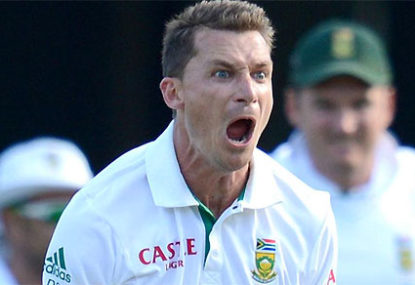The Channel Nine commentators have described the Australian bowling line-up as the best in the world. Even the great Glenn McGrath has stated he has never seen a group of bowlers bowl with such unity.
Ryan Harris, Mitchell Johnson and Peter Siddle are blazing with confidence and their ability to apply the choke with relentless discipline bowling makes them more daunting than their next opponents in Vernon Philander, Dale Steyn and Morne Morkel.
There is no doubt the Australian pace attack are higher in the pecking order. One simple reason is because there line and length are more probing than their South African counterparts.
Against a young Indian batting brigade that were playing in South Africa for the first time, the South African bowlers only managed to make dents in the Indian line-up with the strategy of reverse swing.
In the first match at the Wanderers, on a seaming deck, the South African bowlers bowled way too short and simply didn’t make the batsmen play enough.
On the first day of a Test, the Indian batsmen had managed to leave 50 percent of the balls. In the Ashes so far, the most the England batsmen have managed to leave was 22 percent in Perth.
Philander versus Siddle
Philander is South Africa’s most probing bowler and he is best compared to Siddle. While Philander can destroy a batting line-up in a handful of overs, most of his wickets have come with a new ball or if the pitch has had plenty to offer.
Siddle on the other hand is more of complete bowler. While he can take wickets with the new cherry, it is the Victorian’s ability to take wickets with a ball that is over 30 overs’ old that makes his a greater threat.
Siddle is also a good 5 -10 km/hr quicker than Philander, and with a lovely high arm action can induce more bounce of a pitch.
The fact that Philander is slightly slower and less effective with the old ball means he presents more opportunities for batsmen to score off him once the shine is gone.
Steyn versus Harris
No doubt Harris and Steyn are the best fast bowlers going around.
As good as Steyn is, he can slightly limited with the new ball. With his beautiful wrist position for an outswinger, Steyn barely bowls an inswinger at right-handed batsmen.
The Indian batsmen worked that out quickly. It was amazing to see the Indian batsmen leaving balls pitching on nearly off stump, knowing that Steyn’s natural swing will leave them.
Harris, on the other hand, has the ability to bowl the inswinger to the right handers and to take the ball away from the left handers more proficiently than Steyn.
And of his 87 Test wickets, 59 (nearly 70 percent) are top six batsmen.
With the Indian batsmen able to leave Steyn because of the natural swing he tried too often for the magic outswinger (pitching on leg and hitting off), in the process dishing out too many freebies on leg stump.
Steyn does hold the aces on Harris when it comes to reverse swing.
If pitches in South Africa are abrasive then Steyn’s ability to move the ball through the air at higher pace makes him formidable.
Steyn has the ability to bowl a magic ball, but in the process he can also dish up scoring opportunities.
Harris’ ability to bowl the fuller nagging length make him lethal. But with pitches unlikely to on the drier side, Harris could well be ahead in this battle.
Johnson versus Morkel
Both bowlers have the ability to bowl with hostility and create disconcerting bounce for the batsmen – Morkel with his height and Johnson with his pace.
Johnson, with his low arm action, is difficult to pick up, and therefore a lot difficult to duck underneath. Morkel’s natural length is short so it becomes easier for batsmen to negotiate his short balls.
Morkel is at his best when he bowls a length that ensures the ball hits the top of off stump, but unfortunately for South Africa he simply doesn’t do it often enough.
Some India’s first-timers in South Africa were able to leave him with ease.
While Morkel’s figures might look pretty, Johnson’s angle from around the wicket and his ability to make the batsmen play more frequently keeps the batsmen guessing more than Morkel.
Finally, Johnson has the ability to bowl the yorker – a ball Morkel has struggled to develop. The different angle Johnson creates also ensures Australia has nice variety to their attack.
South Africa don’t have a spinner to compete with Lyon, and with Kallis retiring they don’t have an answer to Watson.
As a group, Australian bowlers have more variety. They are more probing and with Craig McDermott on board bowl a length that will trouble the batsmen more than the South Africans.
On top of that they are more disciplined, and with a fine captain can execute either an attacking or defensive game plan more effectively than their South African counterparts.






























































































